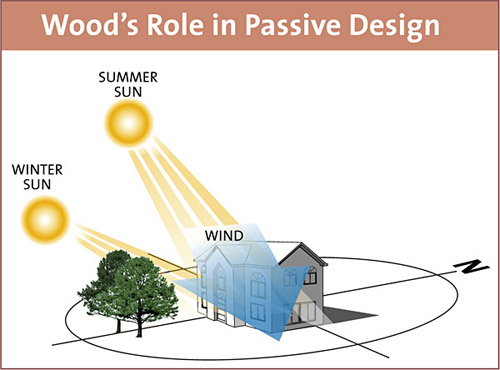Wood Rates: How Wood Products Stack Up in Green Building Systems
Passive design. Defined as building design that permits the use of natural processes - convection, absorption, radiation, and conduction - to minimize energy consumption and improve thermal comfort, passive design has made strides in Europe, where Passivhaus Institute administers a rating system defined by energy use intensity targets. Researchers in Europe have identified wood as a suitable material in the development of passive buildings due to its unique combination of properties, including thermal resistance, natural finish, structural integrity, light weight and weatherproof qualities. Awareness and adoption of the principles of passive design are only now taking root in North America and no current rating system directly references passive design strategies, dematerialization or material efficiency. Goodland notes that passive design is beginning to be incorporated in small buildings in North America through the use of structural wood panels. "This enables wood to be considered in the context of the energy and atmosphere sections of rating systems," she says.
 |
Source: "Passive Design Guide for Homes, prepared for the City of Vancouver by Light House Sustainable Building Centre and Guido Wimmers," November 2008 |
Wood fiber insulation. Having made its way into European markets for its thermal performance, low carbon footprint, ease of installation and its well-being when compared to glass fiber batt and urethane foams and boards, wood fiber insulation has a definite advantage that may one day be recognized by the rating systems. "Today, rating systems do not reference material performance in fire, specifically toxicity," says Goodland. "But if they did, wood would be at an advantage compared to, for example, polyisocyanurate board."
An Evolving Situation
The full potential of wood as a genuine green building material with the capability to get to carbon neutrality may well be under-recognized, at least by the rating systems. Those systems dedicated to home building are most favorably disposed to the use of wood, while rating systems dedicated to commercial building are at best indifferent to the prevalence of wood. Goodland calls North American building codes generally too prescriptive (unlike European performance-based codes) so material choices are driven by conventional views of durability. Moreover, current pricing structures do not include the true external costs of products in terms of transportation, raw materials, and the like, and the industry is also constrained by liability issues and risks inherent in innovation.
"Currently designers are not motivated to consider the global warming potential of the materials they choose because there are no regulations, incentives or best practice standards," says Goodland. "But after the Copenhagen Climate Change Summit in December 2009, global policy priorities are shifting to greater awareness of the value of low carbon solutions in the fight against climate change. In the future, builders will almost certainly be held accountable for their building's performance during construction and operation. International building standards will start to align around energy performance and carbon neutrality - and the benefits of wood as a renewable resource with low-embodied energy will play their part."
 |
The reThink Wood initiative is a coalition of interests representing North America's wood products industry and related stakeholders. The coalition shares a passion for wood and the forests they come from. Innovative new technologies and building systems have enabled longer wood spans, taller walls and higher buildings, and continue to expand the possibilities for wood use in construction. www.rethinkwood.com |








